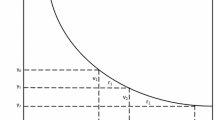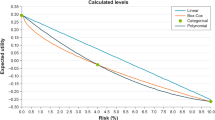Abstract
This paper presents an integrated framework for evaluating the reduction of several types of mortality risk using a Choice Experiment (CE) approach, a type of stated preference technique. Using this approach, we can distinguish the marginal willingness to pay (MWTP) for the amount of risk reduction from the MWTP for the opportunity of risk reduction and therefore calculate the “Quantity-based” Value of a Statistical Life. The risks in our survey include mortality risks due to accident, cancer, and heart disease. The Quantity-based VSL is calculated to be 350 million JPY (in 2002 Japanese Yen, about 2.9 million US dollars). Furthermore, we analyzed the influence of subjective risk perception and population characteristics of the respondents on their MWTP. Estimated results suggest that it is unnecessary to adjust the VSL according to the differences in the type of risk if the VSL is calculated using an adequate approach. However, adjustments for the timing of risk reduction and population characteristics are found to be significant for the execution of benefit transfer.
Similar content being viewed by others
References
Aldy, Joseph E. and W. Kip Viscusi. (2004). “Age Variations in Workers’ Value of A Statistical Life,” Discussion Paper No. 468, March 2004, The Harvard John M. Olin Discussion Paper Series.
Alberini, Anna, Maureen Cropper, Alan Krupnick, and Nathalie B. Simon. (2002). “Does the Value of a Statistical Life Vary with Age and Health Status? Evidence from the United States and Canada”, Discussion Paper 02-19, Resources for the Future, Washington, D.C.
Corso, Phaedra S., James K. Hammitt, and John D. Graham. (2001). “Valuing Mortality-Risk Reduction: Using Visual Aids to Improve the Validity of Contingent Valuation,” Journal of Risk and Uncertainty 23(2), 165–184.
Hammitt, James K. and John D. Graham. (1999). “Willingness to Pay for Health Protection: Inadequate Sensitivity to Probability?” Journal of Risk and Uncertainty 18(1), 33–62.
Hammitt, James K. and Jin-Tan Liu. (2004). “Effects of Disease Type and Latency on the Value of Mortality Risk,” Journal of Risk and Uncertainty 28(1), 73–95.
Hammitt, James K., Jin-Tan Liu, and Jin-Long Liu. (2000). “Survival is a Luxury Good: The Increasing Value of a Statistical Life,” Paper Prepared for the NBER Summer Institute Workshop on Public Policy and the Environment, Cambridge, Massachusetts, August 2000.
Jones-Lee, Michael. (1974). “The Value of Changes in the Probability of Death or Inquiry,” Journal of Political Economy 82, 835–849.
Jones-Lee, Michael W., Max Hammerton, and Peter Philips. (1985). “The Value of Safety: Results of a National Sample Survey,” Economic Journal 95, 49–72.
Jones-Lee, Michael W., and Graham Loomes. (1995). “Scale and Context Effects in the Valuation of Transport Safety,” Journal of Risk and Uncertainty 11, 183–203.
Krinsky, Itzhak and A. Leslie Robb. (1986). “Approximating the Statistical Properties of Elasticities,” Review of Economics and Statistics, 68, 715–719.
Krupnick, Alan, Anna Alberini, Maureen Cropper, Nathalie Simon, Bernie O’Brien, Ron Goeree, and Martin Heintzelman. (2002). “Age, Healv and the Willingness to Pay for Mortality Risk Reductions: A Contingent Valuation Survey of Ontario Residents,” Journal of Risk and Uncertainty 24, 161–186.
Louviere, Jordan J., David A. Hensher, and Joffre D. Swait. (2000). Stated Choice Methods: Analysis and Application, Cambridge University Press.
Magat, Wesley A., W. Kip Viscusi, and Joel Huber. (1996). “A Reference Lottery Metric for Valuing Health,” Management Science 42(8), 1118–1130.
McDaniels, Timothy L., Mark S. Kamlet, Gregory W. Fischer. (1992). “Risk Perception and the Value of Safety,” Risk Analysis 12, 495–503.
McFadden, Daniel. (1974). “Conditional Logit Analysis of Qualitative Choice Behavior.” In Paul Zarembka (ed.), Frontiers in Econometrics, Academic Press, pp. 105–142.
NERA/CASPAR (1998). Valuation of Deaths from Air Pollution. London.
Savage, Ian. (1993). “An Empirical Investigation into the Effect of Psychological Perception on the Willingness-to-Pay to Reduce Risk,” Journal of Risk and Uncertainty 6, 75–90.
Subramanian, Uma, and Maureen Cropper. (2000). “Public Choices between Life Saving Programs: The Tradeoff Between Qualitative Factors and Lives Saved,” Journal of Risk and Uncertainty 21, 117–149.
U.K. Department of Health. (1999). Economic Appraisal of the Health Effects of Air Pollution. The Stationery Office.
U.S. Environmental Protection Agency. (2000). Valuing Fatal Cancer Risk Reductions, January 21.
U.S. Office of Management and Budget. (2003). Memorandum from John D. Graham to the President’s Management Council on “Benefit-Cost Methods and Lifesaving Rules,” May 30, 2003. (http://www.whitehouse.gov/omb/inforeg/pmc_benefit_cost_memo.pdf)
Viscusi, W. Kip (1993). “The Value of Risks to Life and Health,” Journal of Economic Literature 31, 1912–1946.
Viscusi, W. Kip and Joseph E. Aldy. (2003). “The Value of A Statistical Life: A Critical Review of Market Estimates Throughout the World,” Journal of Risk and Uncertainty 27, 5–76.
Weinstein, Milton C., Donald S. Shepard, and Joseph S. Pliskin. (1980). “The Economic Value of Changing Mortality Probabilities: A Decision-Theoretic Approach,” Quarterly Journal of Economics 94, 373–396.
Author information
Authors and Affiliations
Corresponding author
Additional information
JEL Classification: I18, D81, J17
Rights and permissions
About this article
Cite this article
Tsuge, T., Kishimoto, A. & Takeuchi, K. A Choice Experiment Approach to the Valuation of Mortality. J Risk Uncertainty 31, 73–95 (2005). https://doi.org/10.1007/s11166-005-2931-6
Issue Date:
DOI: https://doi.org/10.1007/s11166-005-2931-6




